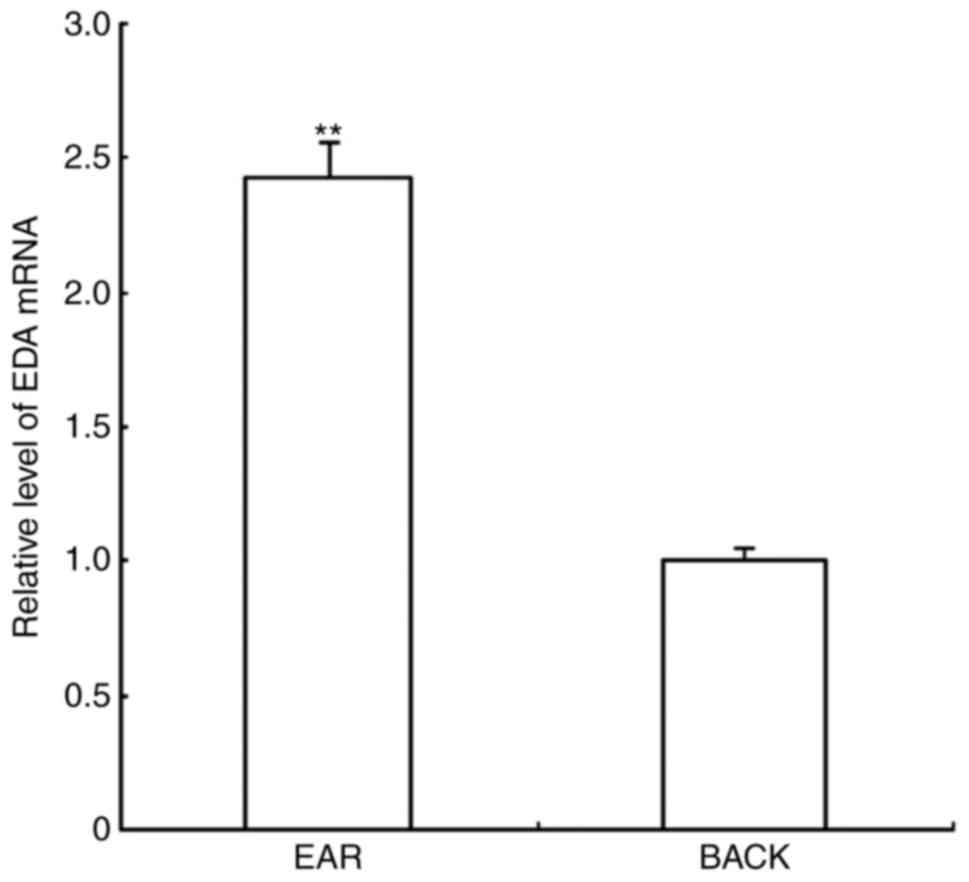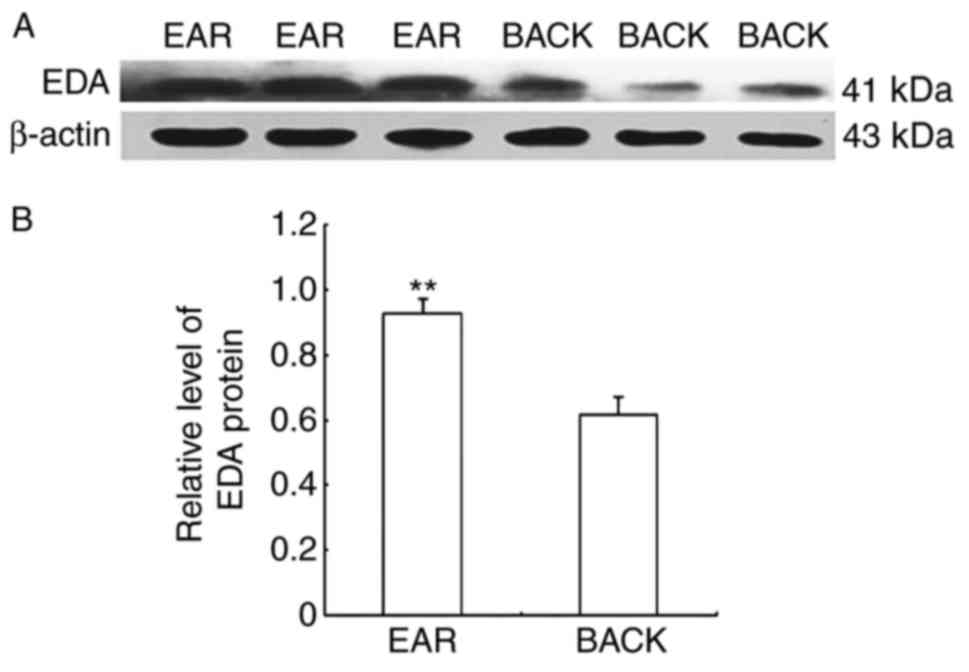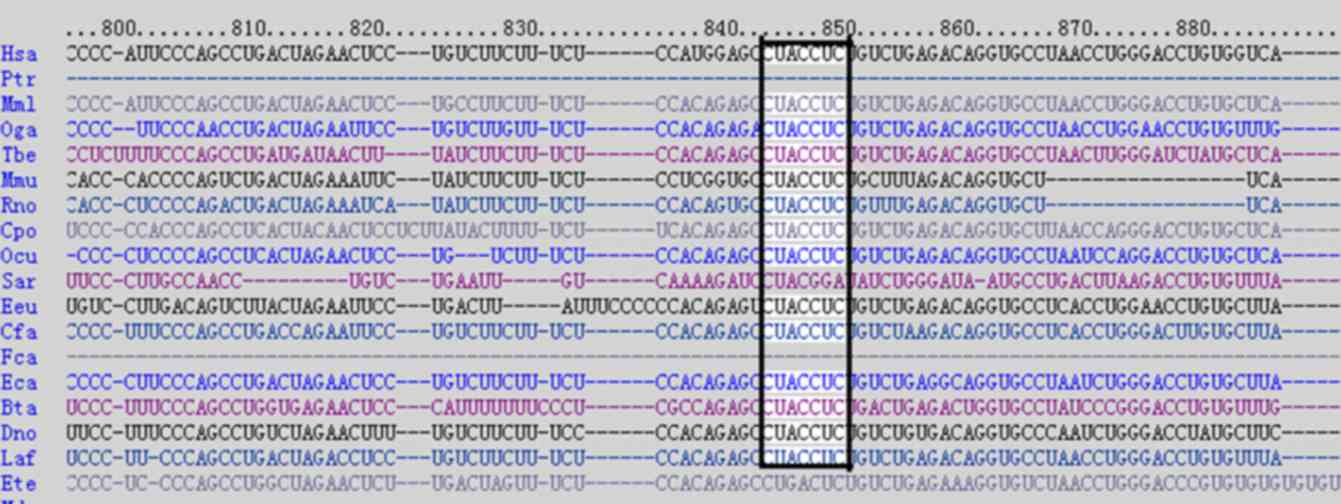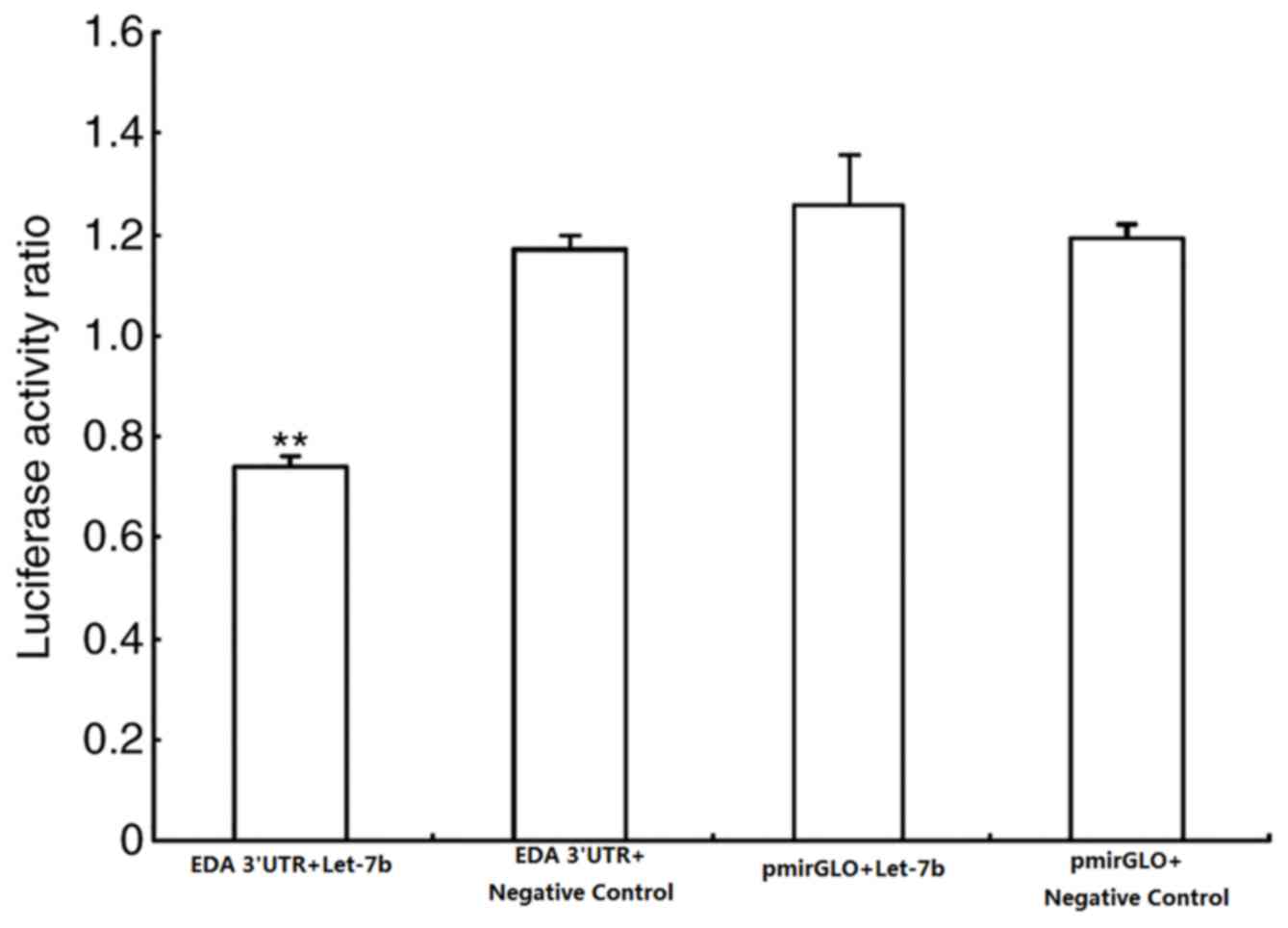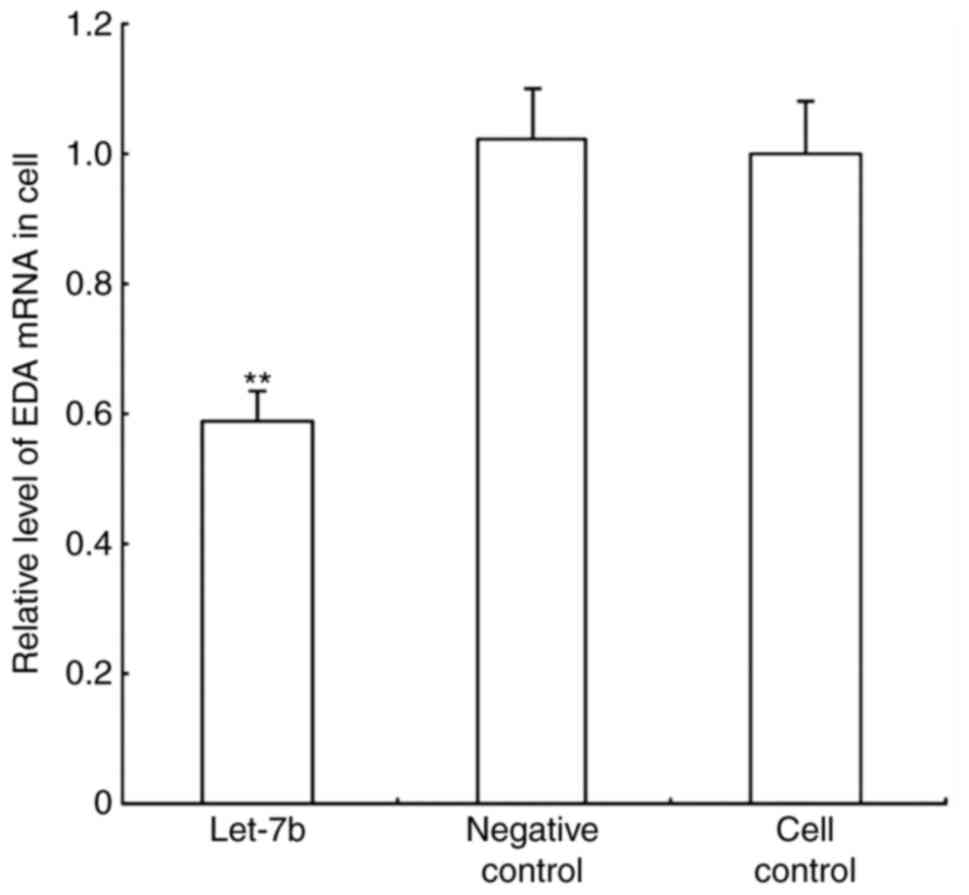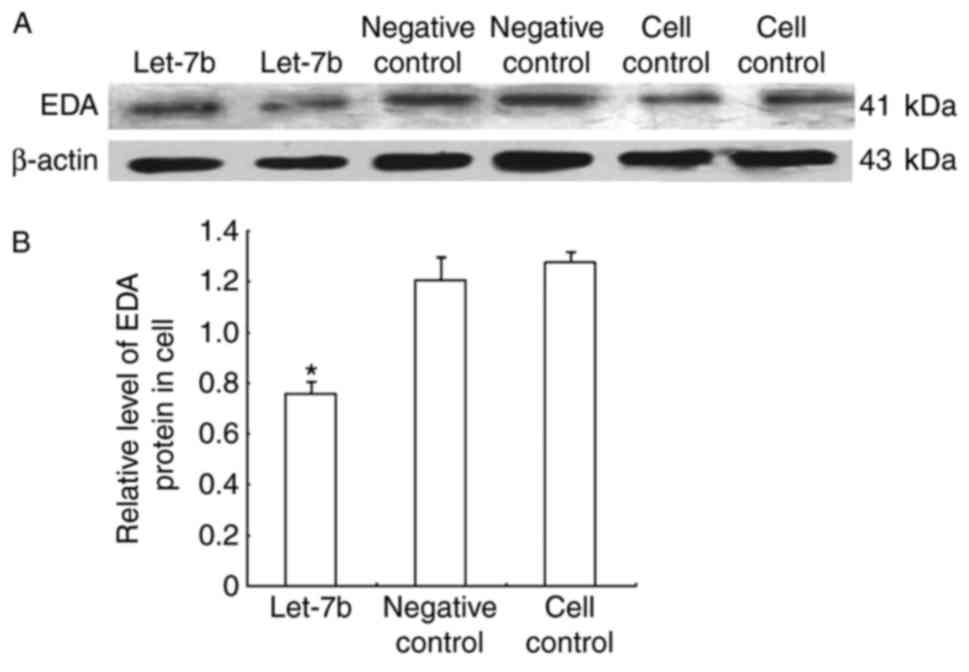|
1
|
Wang N, Rong EG and Yan XH: Research
progress of hair follicle development and hair production. J
Northeast Agric Univ. 43:6–11. 2012.
|
|
2
|
Zhu Z, He J, Dong C, Jiang J, Bai R, Yu X,
Lv L, Fan R, He X, Geng J, et al: MicroRNA-25 functions in
regulation of pigmentation by targeting the transcription factor
MITF in alpaca (Lama pacos) skin melanocytes. Domest Anim
Endocrinol. 38:200–209. 2010. View Article : Google Scholar : PubMed/NCBI
|
|
3
|
Dong Y, Cao J, Wang H, Zhang J, Zhu Z, Bai
R, Hao H, He X, Fan R and Dong C: Nitric oxide enhances the
sensitivity of alpaca melanocytes to respond to
alpha-melanocyte-stimulating hormone by up-regulation
melanocortin-1 receptor. Biochem Biophys Res Commun. 396:849–853.
2010. View Article : Google Scholar : PubMed/NCBI
|
|
4
|
Geng JJ, Mu XL, Suan LT, Jiang JB, Zhang
J, Li HQ, Zhang Y and Dong CS: Expression and immunolocalization of
endothelin receptor B in Alpaca skin of different colors. Acta
Veterinaria et Zootechnica Sinica. 41:1478–1484. 2010.
|
|
5
|
Sand M, Gambichler T, Sand D, Skrygan M,
Altmeyer P and Bechara FG: MicroRNAs and the skin: Tiny players in
the body's largest organ. J Dermatol Sci. 53:169–175. 2009.
View Article : Google Scholar : PubMed/NCBI
|
|
6
|
He XY, Hao HQ, Liu DD, Fan RW, Cao J, Zhu
ZW, Dong YJ and Xing HQ: Difference of microRNA expression in the
ear and back skin of Young Alpaca (Lama pacos). Chin J Biochem Mol
Biol. 26:1016–1022. 2010.
|
|
7
|
Kere J, Srivastava AK, Montonen O, Zonana
J, Thomas N, Ferguson B, Munoz F, Morgan D, Clarke A, Baybayan P,
et al: X-linked anhidrotic (hypohidrotic) ectodermal dysplasia is
caused by mutation in a novel transmembrane protein. Nat Genet.
13:409–416. 1996. View Article : Google Scholar : PubMed/NCBI
|
|
8
|
Visinoni AF, Lisboa-Costa T, Pagnan NA and
Chautard-Freire-Maia EA: Ectodermal dysplasias: Clinical and
molecular review. Am J Med Genet A. 149A:1–2002. 2009. View Article : Google Scholar
|
|
9
|
Pinheiro M and Freire-Maia N: Ectodermal
dysplasias: A clinical classification and a causal review. Am J Med
Genet. 53:153–162. 1994. View Article : Google Scholar : PubMed/NCBI
|
|
10
|
Clarke A, Phillips DI, Brown R and Harper
PS: Clinical aspects of X-linked hypohidrotic ectodermal dysplasia.
Arch Dis Child. 62:989–996. 1987. View Article : Google Scholar : PubMed/NCBI
|
|
11
|
Mustonen T, Pispa J, Mikkola ML, Pummila
M, Kangas AT, Pakkasjärvi L, Jaatinen R and Thesleff I: Stimulation
of ectodermal organ development by ectodyplasin-A1. Dev Biol.
259:123–136. 2003. View Article : Google Scholar : PubMed/NCBI
|
|
12
|
Zhang M, Brancaccio A, Weiner L, Missero C
and Brissette J: Ectodysplasin regulates pattern formation in the
mammalian hair coat. Genesis. 37:30–37. 2003. View Article : Google Scholar : PubMed/NCBI
|
|
13
|
Jiang W, Xue P, He YX and Chen YL:
Molecular cloning, sequence analysis and expression of goat Eda
gene. J Northwest A F Univ (Nat. Sci. Ed). 40:7–12. 2012.
|
|
14
|
Liu DD, Zhang ZY, He XY, Dong YJ, Zhu ZW,
Bai R, Zhang J, Hao HQ and Xing HQ: FGF5 expression and
immunolocalization in back and ear skin of young alpaca (Lama
pacos). Chin J Bioch Mol Biol. 5:473–479. 2011.
|
|
15
|
Tian X, Jiang J, Fan R, Wang H, Meng X, He
X, He J, Li H, Geng J, Yu X, et al: Identification and
characterization of microRNAs in white and brown alpaca skin. BMC
Genomics. 13:5552012. View Article : Google Scholar : PubMed/NCBI
|
|
16
|
Livak KJ and Schmittgen TD: Analysis of
relative gene expression data using real-time quantitative PCR and
the 2(-Delta Delta C(T)) method. Methods. 25:402–408. 2001.
View Article : Google Scholar : PubMed/NCBI
|
|
17
|
Cekanova M, Uddin MJ, Bartges JW, Callens
A, Legendre AM, Rathore K, Wright L, Carter A and Marnett LJ:
Molecular imaging of cyclooxygenase-2 in canine transitional cell
carcinoma as in vitro and in vivo. Cancer Prev Res (Phila).
6:466–476. 2013. View Article : Google Scholar : PubMed/NCBI
|
|
18
|
Lee RC, Feinbaum RL and Ambros V: The C.
Elegans heterochronic gene lin-4 encodes small RNAs with antisense
complementarity to lin-14. Cell. 75:843–854. 1993. View Article : Google Scholar : PubMed/NCBI
|
|
19
|
Lagos-Quintata M, Rauhut R, Lendeckel W
and Tuschl T: Identification of novel genes coding for small
expressed RNAs. Science. 294:853–858. 2001. View Article : Google Scholar : PubMed/NCBI
|
|
20
|
Lee RC and Ambros V: An extensive class of
small RNAs in Caenorhabditis elegans. Science. 294:862–864. 2001.
View Article : Google Scholar : PubMed/NCBI
|
|
21
|
Dostie J, Mourelatos Z, Yang M, Sharma A
and Dreyfuss G: Numerous microRNPs in neuronal cells containing
novel microRNAs. RNA. 9:180–186. 2003. View Article : Google Scholar : PubMed/NCBI
|
|
22
|
Lim LP, Glasner ME, Yekta S, Burge CB and
Bartel DP: Vertebrate microRNA genes. Science. 299:15402003.
View Article : Google Scholar : PubMed/NCBI
|
|
23
|
Lim LP, Lau NC, Weinsstein EG, Abdelhakim
A, Yekta S, Rhoades MW, Burge CB and Bartel DP: The microRNAs of
Caenorhabditis elegans. Genes Dev. 17:991–1008. 2003. View Article : Google Scholar : PubMed/NCBI
|
|
24
|
Grad Y, Aach J, Hayes GD, Reinhart BJ,
Church GM, Ruvkun G and Kim J: Computational and experimental
identification of C. Elegans microRNAs. Mol Cell. 11:1253–1263.
2003. View Article : Google Scholar : PubMed/NCBI
|
|
25
|
Reinhart BJ, Weinsstein EG, Rhoades MW,
Bartel B and Bartel DP: MicroRNAs in plants. Genes Dev.
16:1616–1626. 2002. View Article : Google Scholar : PubMed/NCBI
|
|
26
|
Lau NC, Lim LP, Weinsstein EG and Bartel
DP: An abundant class of tiny RNAs with probable regulatory roles
in Caenorhabditis elegans. Science. 294:858–862. 2001. View Article : Google Scholar : PubMed/NCBI
|
|
27
|
Kim J, Krichevsky A, Grad Y, Hayes GD,
Kosik KS, Church G and Ruvkun G: Identification of many microRNAs
that copurify with polyribosomes in mammalian neurons. Pro Natl
Acad Sci USA. 101:360–365. 2004. View Article : Google Scholar
|
|
28
|
Liu DD, He XY and Hao HQ: The regulatory
role of microRNAs in the development of animal skin and hair. Chin
J Biochem Mol Biol. 26:802–808. 2010.
|
|
29
|
Wang T, Zhang Y, Wang HD, Shen Y, Liu N,
Cao J, Yu XJ, Dong CS and He XY: Alpaca fiber growth is mediated by
microRNA let-7b via down-regulation of target gene FGF5. Genet Mol
Res. 14:13754–13763. 2015. View Article : Google Scholar : PubMed/NCBI
|
|
30
|
Yan S, Yu Z, Ning L, Hai-Dong W, Jian-Shan
X, Shu-Yuan G, Jia-Qi C, Xiu-Ju Y, Ting W, Chang-Sheng D and
Xiao-Yan H: Let-7b promotes alpaca hair growth via transcriptional
repression of TGFβR I. Gene. 577:32–36. 2016. View Article : Google Scholar : PubMed/NCBI
|
|
31
|
Weih F and Caamaño J: Regulation of
secondary lymphoid organ development by the nuclear factor-kappaB
signal transduction pathway. Immunol Rev. 195:91–105. 2003.
View Article : Google Scholar : PubMed/NCBI
|
|
32
|
Headon DJ, Emmal SA, Ferguson BM, Tucker
AS, Justice MJ, Sharpe PT, Zonana J and Overbeek PA: Gene defect in
ectodermal dysplasia implicates a death domain adapter in
development. Nature. 414:913–916. 2001. View Article : Google Scholar : PubMed/NCBI
|
|
33
|
Cui CY and Schlessinger D: EDA signaling
and skin appendage development. Cell Cycle. 5:2477–2483. 2006.
View Article : Google Scholar : PubMed/NCBI
|
|
34
|
Botchkarev VA and Fessing MY: Edar
signaling in the control of hair follicle development. J Investig
Dermatol Symp Proc. 10:pp. 247–251. 2005; View Article : Google Scholar : PubMed/NCBI
|
|
35
|
Alvarez-Garcia I and Miska EA: MicroRNA
functions in animal development and human disease. Development.
132:4653–4662. 2005. View Article : Google Scholar : PubMed/NCBI
|
|
36
|
Naguibneva I, Ameyar-Zazoua M, Polesskaya
A, Ait-Si-Ali S, Groisman R, Souidi M, Cuvellier S and Harel-Bellan
A: The microRNA miR-181 targets the homeobox protein Hox-A11 during
mammalian myoblast differentiation. Nat Cell Biol. 8:278–284. 2006.
View Article : Google Scholar : PubMed/NCBI
|
|
37
|
Jakymiw A, Lian SL, Eystathioy T, Li S,
Satoh M, Hamel JC, Fritzler MJ and Chan KL: Disruption of GW bodies
impairs mammalian RNA interference. Nat Cell Biol. 7:1267–1274.
2005. View
Article : Google Scholar : PubMed/NCBI
|
|
38
|
Naguibneva I, Ameyar-Zazoua M, Nonne N,
Polesskaya A, Ait-Si-Ali S, Groisman R, Souidi M, Pritchard LL and
Harel-Bellan A: An LNA-based loss-of-function assay for micro-RNAs.
Biomed Pharmacother. 60:633–638. 2006. View Article : Google Scholar : PubMed/NCBI
|



